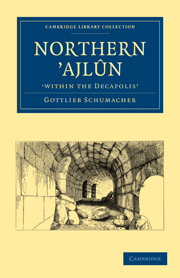Summary
NÂHIYET EL-WUSTÎYEH
THE Nâhiyet el-Wustîyeh is bordered on the north by the Wâd el-ʾArab, the Wâd el-Ghafr, and the Nâhiyet es-Siru; on the east by the Nâhiyet Ben Juhma; on the south by the Wâd et-Taiyibeh and the Nâhiyet el-Kûra; and on the west by the Ghôr. It lies thus in the midst of the other Nahiyets, and from this fact its name of El- Wustiyeh (the Middle District) is derived. The north-western portion of the District is a rolling country sloping down to the Wâd el-ʾArab, the remainder is a plateau country, intersected by numerous Wâdies and covered with oak wood. The plateau was at one time thickly settled, although its soil is rather poor; the population is now scanty.
Its principal villages are Kefr Esad and Et Taiyibeh.
Kefr Esad (1,151 feet above the sea.—The village is nearly on a level with Umm Keis; it is built in two quarters. The southern quarter, numbering twenty huts and containing a population of 100 souls of the families of the “Fukara” or “Shiyûkh” (Fakirs or Sheikhs). The northern quarter consists of some fifty huts, Occupied by the Fellahin and numbers some 250 souls. The “Sheikhs” form a caste apart, considering themselves saints, and excluding from their company the profane Fellahin of the northern quarter; they are greatly venerated by the latter, and have built themselves a number of miserable huts, in which they live on the revenues afforded by the shrine of a Mohammedan saint called Sheikh Mohammed el-ʾUdamy.
- Type
- Chapter
- Information
- Northern ’Ajlûn, 'within the Decapolis' , pp. 119 - 147Publisher: Cambridge University PressPrint publication year: 2010First published in: 1890

